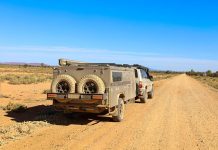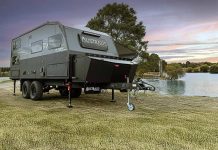When you think about offroad caravanning, which brands of offroad caravan come to mind? Dollars to doughnuts, Trakmaster is on your top five list.
Since the mid 1990s, when the company was established, the company has focussed on custom manufacturing. Neither mass production nor a standardised range of vans were its cup of tea. But following the 2016 sale of Trakmaster to Gason, a company specialising in, among other things, agricultural equipment, times are changing.
The aim is growth. But how to grow a company that only builds its niche product to order? Its obvious: develop a standard range of caravans to a proven, fixed-design format. Trakmaster hopes that this approach will significantly broaden its customer base. After all, taking the custom path isn’t for everyone. Some, as Trakmaster project manager Ron Larkin told GoRV, might find customising their van too intimidating or off-putting. Others mightn’t have the time or inclination.
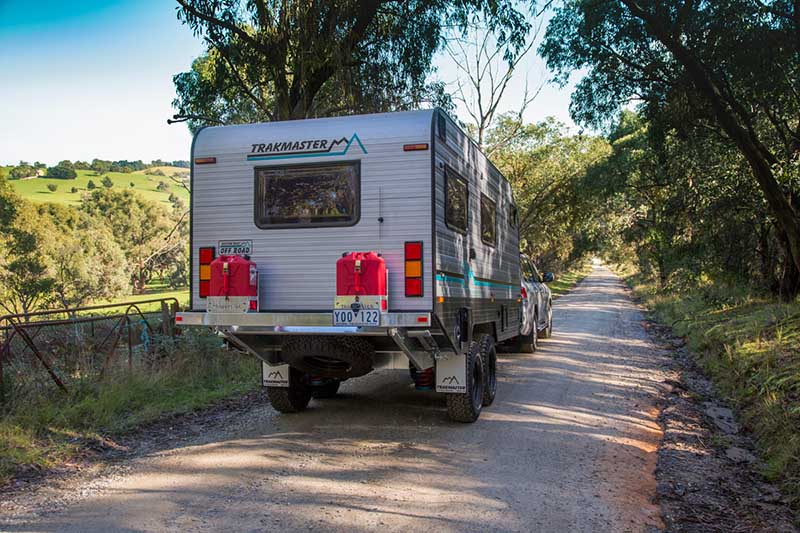 The goal, ultimately, is to increase the appeal of Trakmaster caravans.
The goal, ultimately, is to increase the appeal of Trakmaster caravans.
“We want to grow our business and we want to make it easier for people to buy our vans, especially for people who are new to our products,” he said.
Mr Larkin said that these standard layouts were based on some of the company’s most popular vans as well as customer feedback, and Trakmaster envisions that in six to 12 months these standard-layout vans will represent about half of all the vans it sells.
By the time Trakmaster is done, there will be about 12 fixed-design offroaders available. To kick it off, Trakmaster’s Flinders range has gotten the standardised-layout treatment. We hitched up the 15ft 10in tandem-axle model with one question on our mind: is it as capable as its customised predecessors?
OUTSIDE THE TRAKMASTER FLINDERS
On the freeway, our Flinders was the epitome of a pleasure-to-tow van. There was no side-sway or porpoising on the towbar. As the bitumen gave way to gravel and corrugations, the van’s independent coil suspension (with dual shock absorbers per wheel) really stepped up to the plate. The system, known as ‘Trak-One’ is the company’s own design.
The chassis is a 6in RHS one-piece unit with an extended A-frame, while the rear cutaway should prevent damage when exiting deep ruts or river crossings. Beneath the cutaway you’ll find the spare wheel, which is fitted to a ratchet mechanism to eliminate heavy lifting when it’s time to change a tyre.
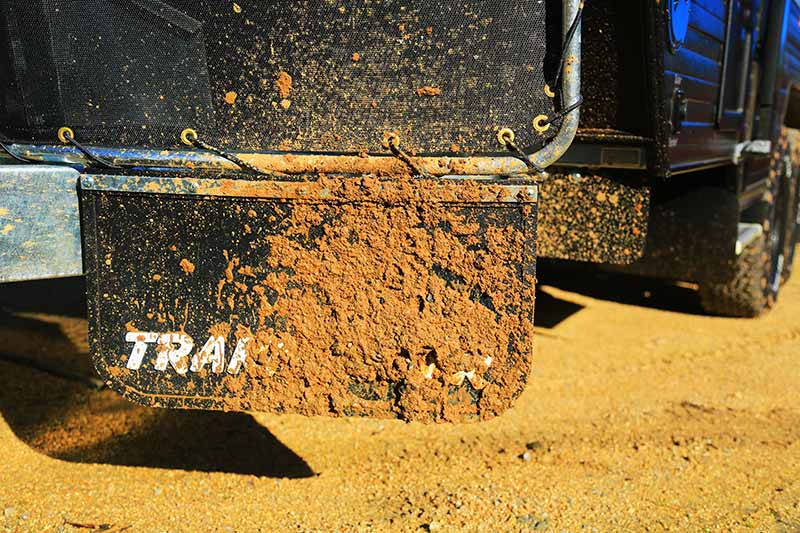 In terms of self-sufficiency, our Flinders covers most bases. Two 82L water tanks (which are well protected by galvanised sheeting) are standard, while a grey water tank can be fitted too. The fresh water tanks are plumbed independently to separate isolating valves under the sink inside. This means you could, for example, fill one tank with non-potable river water, and save the other tank just for drinking water. The van gets two AGM deep-cycle batteries and 300W worth of solar, but the batteries can also be charged off the tow vehicle via the Anderson plug when in transit, or by a set of portable solar panels to augment the roof-mounted system – a dedicated socket is supplied on the nearside. The 12V system is controlled by a Redarc battery management system, which will ensure that the batteries are always being charged in the most efficient way possible.
In terms of self-sufficiency, our Flinders covers most bases. Two 82L water tanks (which are well protected by galvanised sheeting) are standard, while a grey water tank can be fitted too. The fresh water tanks are plumbed independently to separate isolating valves under the sink inside. This means you could, for example, fill one tank with non-potable river water, and save the other tank just for drinking water. The van gets two AGM deep-cycle batteries and 300W worth of solar, but the batteries can also be charged off the tow vehicle via the Anderson plug when in transit, or by a set of portable solar panels to augment the roof-mounted system – a dedicated socket is supplied on the nearside. The 12V system is controlled by a Redarc battery management system, which will ensure that the batteries are always being charged in the most efficient way possible.
Three 20L jerry cans holders are also provided (two at the rear, one at the front), so that’s an extra 60L of fuel or water, or a combination thereof, on hand.
Up front, you’ll find two 8.5 gas cylinders mounted to the drawbar behind a mesh stoneguard, a D035 coupling, a wire-mesh rack for collecting firewood, etc. The front boot is good and spacious, too, and let’s not forget about the nearby right-through pole carrier. A tap has been fitted to the A-frame, too, and it was great to note its position inside the drawbar, where it won’t be vulnerable to stone-strike.
The nearside has a Dometic roll-out awning, but unfortunately the rear vertical arm of the awning blocks the nearside bedroom window. To open this window, you’d first have to open the awning. I can see the dilemma: the vertical awning arm is too long to be set behind the window, due to the rear cutaway.
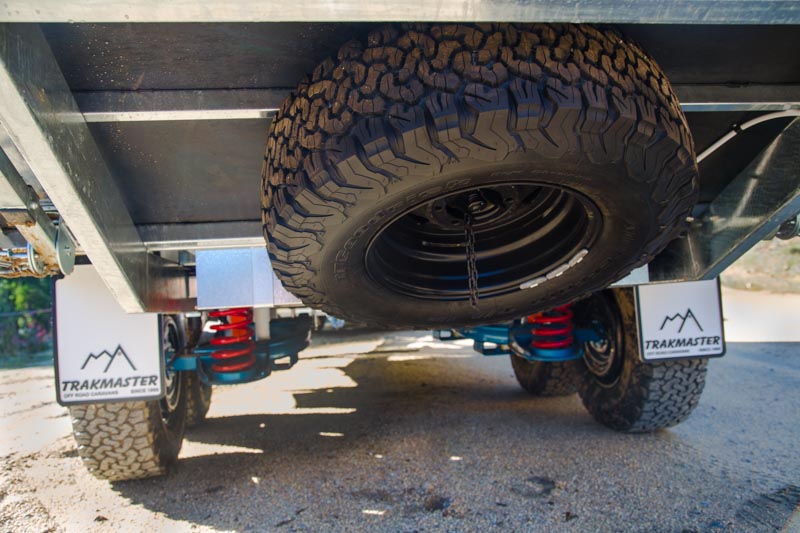 That aside, the Flinders, with its silver aluminium cladding on a meranti timber frame, that upswept tail and purposeful stance on the road, looks every inch the serious offroader. But does the inside match the outside?
That aside, the Flinders, with its silver aluminium cladding on a meranti timber frame, that upswept tail and purposeful stance on the road, looks every inch the serious offroader. But does the inside match the outside?
FLINDERS’ LAYOUT
First things first: the external width of this van is limited to a svelte 7ft 1in. This makes sense. It’s narrower wheelbase means the van will follow the wheel tracks of the tow vehicle. It also means it will be able to negotiate tight bush tracks better than bigger units, while also reducing the number of bush pinstripes and dents.
The interior, you might think, would therefore feel pokey. But the layout of the Flinders 15ft 10in is rather clever. The full-width queen-size bed sits atop the rear cutaway, with a nearside dinette and offside kitchen in the middle of the van, and a bathroom at the front. Even the overall storage capacity of the van seems more than generous. The kitchen, dinette and bed are wrapped in overhead lockers, although the under-bed storage space is inevitably less deep due to the tapered floor resulting from the cutaway. It’s also where you’ll find the 23L gas-electric Suburban hot water service.
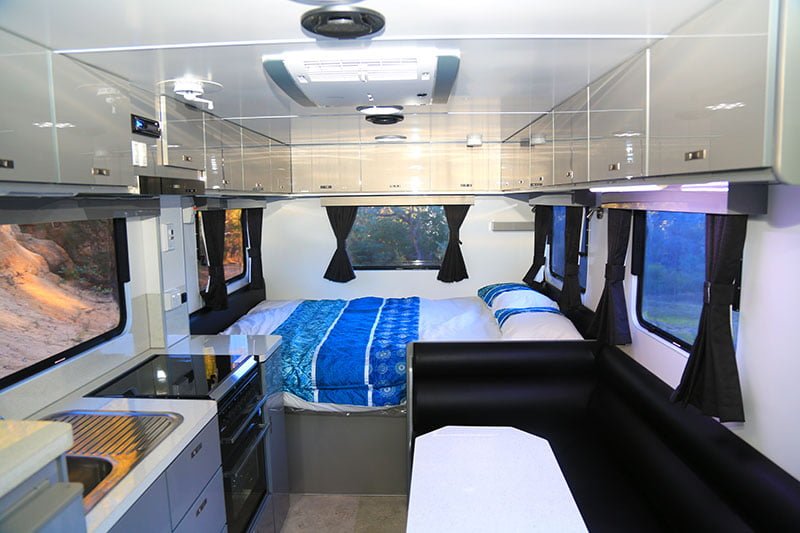 Furthermore, the storage space beneath the dinette is more accessible than you might think. You need to remove the two cushions but, unlike in some vans I’ve seen, they come out and – more importantly – go back in without fuss. Beneath the ply base of the cushions is where you’ll find the 12V nerve centre – the Redarc BMS.
Furthermore, the storage space beneath the dinette is more accessible than you might think. You need to remove the two cushions but, unlike in some vans I’ve seen, they come out and – more importantly – go back in without fuss. Beneath the ply base of the cushions is where you’ll find the 12V nerve centre – the Redarc BMS.
The ever-present need to charge our 21st century gadgetry hasn’t been forgotten, either, with a couple of USB and traditional 12V points provided throughout.
Finally, the front bathroom. Yes, it has the standard gear: a nearside cassette toilet, vanity, offside moulded fibreglass shower, etc. But what really struck me is the head space. The van tapers at the very front but for about the first 450mm, the roof remains at its full height. So in the parts of the bathroom where you actually need to stand, you can do so without stooping. The effect is to make the bathroom feel more spacious than its physical dimensions would suggest.
The interior of the van is certainly modern. The gloss finish to the cabinetry, the full cooking facilities (including an oven), the reverse-cycle air-conditioner and the 146L EvaKool compressor fridge-freezer… I fail to see how anyone would be uncomfortable in this rig.
GORV’S VERDICT
Will the shake-up at Trakmaster result in a broader market share? Time will tell. But
it does look like the future remains bright at Trakmaster. And, going by this Flinders, the company’s attempt to stake a larger claim by offering fixed-design caravans is not at the expense of its genuine offroad roots.
THE SCORE
FIT AND FINISH – 
LAYOUT – 
INNOVATION – 
HITS & MISSES
COMPLETE SPECS
Overall length: 23ft 5in (7.15m)
External cabin length: 17ft 5in (5.31m)
External cabin width: 7ft in (2.16m) / 7ft 8in (2.34m) including awning
Travel height: 9ft 11in (3.02m)
Internal height: 6ft 3in (1.91m)
Tare: 2286kg
GTM: 2700kg
ATM: 3000kg
Unladen ball weight: 230kg
Frame: Meranti timber
Cladding: Aluminium
Coupling: D035
Chassis: 6in hot-dipped galvanised; extended drawbar
Suspension: ‘Trak-One’ independent coil
Brakes: 12in Dexter electri with heavy duty stub axles
Wheels: 16in black steel rims
Fresh water: 2x82L (110L in production models)
Grey water: Provision for future fitment
Awning: Dometic roll-out
Battery: 2x120Ah AGM deep-cycle with Redarc BMS
Solar: 2x150W
Air-conditioner: Truma Aventa reverse-cycle
Gas cylinders: 2×8.5kg
Sway control: No
Cooking: Swift four-burner with griller and oven
Refrigeration: 142L EvaKool compressor
Microwave: Yes
Toilet: Yes
Shower: Yes
Washing machine: No
Lighting: 12V LED
Hot water: 23L Suburban gas-electric
RRP: $95,000


